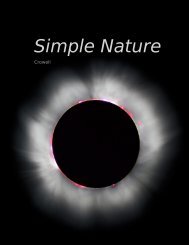Chapter 3 Acceleration and free fall - Light and Matter
Chapter 3 Acceleration and free fall - Light and Matter
Chapter 3 Acceleration and free fall - Light and Matter
You also want an ePaper? Increase the reach of your titles
YUMPU automatically turns print PDFs into web optimized ePapers that Google loves.
a / Aristotle said motion had<br />
to be caused by a force. To<br />
explain why an arrow kept flying<br />
after the bowstring was no longer<br />
pushing on it, he said the air<br />
rushed around behind the arrow<br />
<strong>and</strong> pushed it forward. We know<br />
this is wrong, because an arrow<br />
shot in a vacuum chamber does<br />
not instantly drop to the floor<br />
as it leaves the bow. Galileo<br />
<strong>and</strong> Newton realized that a force<br />
would only be needed to change<br />
the arrow’s motion, not to make<br />
its motion continue.<br />
Newton had to be coaxed by his friends into publishing a book on<br />
his physical discoveries. Where Galileo’s writing had been popular<br />
<strong>and</strong> dramatic, Newton originated the stilted, impersonal style that<br />
most people think is st<strong>and</strong>ard for scientific writing. (Scientific journals<br />
today encourage a less ponderous style, <strong>and</strong> papers are often<br />
written in the first person.) Galileo’s talent for arousing animosity<br />
among the rich <strong>and</strong> powerful was matched by Newton’s skill at<br />
making himself a popular visitor at court. Galileo narrowly escaped<br />
being burned at the stake, while Newton had the good fortune of being<br />
on the winning side of the revolution that replaced King James<br />
II with William <strong>and</strong> Mary of Orange, leading to a lucrative post<br />
running the English royal mint.<br />
Newton discovered the relationship between force <strong>and</strong> motion,<br />
<strong>and</strong> revolutionized our view of the universe by showing that the<br />
same physical laws applied to all matter, whether living or nonliving,<br />
on or off of our planet’s surface. His book on force <strong>and</strong> motion,<br />
the Mathematical Principles of Natural Philosophy, was uncontradicted<br />
by experiment for 200 years, but his other main work,<br />
Optics, was on the wrong track, asserting that light was composed<br />
of particles rather than waves. Newton was also an avid alchemist,<br />
a fact that modern scientists would like to forget.<br />
4.1 Force<br />
124 <strong>Chapter</strong> 4 Force <strong>and</strong> motion<br />
We need only explain changes in motion, not motion itself.<br />
So far you’ve studied the measurement of motion in some detail,<br />
but not the reasons why a certain object would move in a certain<br />
way. This chapter deals with the “why” questions. Aristotle’s ideas<br />
about the causes of motion were completely wrong, just like all his<br />
other ideas about physical science, but it will be instructive to start<br />
with them, because they amount to a road map of modern students’<br />
incorrect preconceptions.<br />
Aristotle thought he needed to explain both why motion occurs<br />
<strong>and</strong> why motion might change. Newton inherited from Galileo the<br />
important counter-Aristotelian idea that motion needs no explanation,<br />
that it is only changes in motion that require a physical cause.<br />
Aristotle’s needlessly complex system gave three reasons for motion:<br />
Natural motion, such as <strong>fall</strong>ing, came from the tendency of<br />
objects to go to their “natural” place, on the ground, <strong>and</strong><br />
come to rest.<br />
Voluntary motion was the type of motion exhibited by animals,<br />
which moved because they chose to.<br />
Forced motion occurred when an object was acted on by some<br />
other object that made it move.














